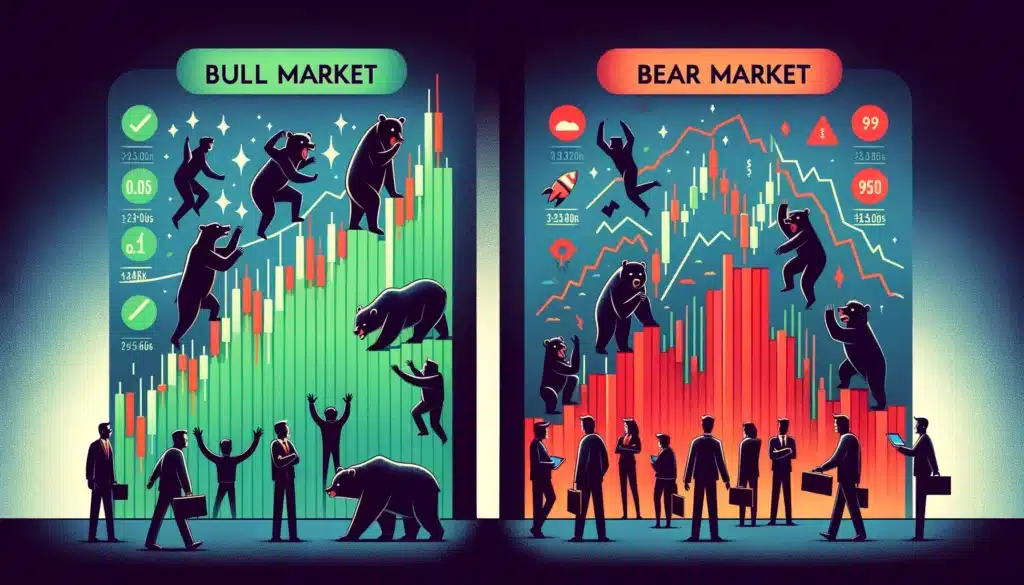Quick Answer: So, What is a Bull Market?
A bull market is a financial market condition where prices are rising or expected to rise. In cryptocurrency, this trend indicates growing investor confidence and increased buying activity, often driven by positive news, strong economic indicators, or technological advancements in the sector.

Don’t invest unless you’re prepared to lose all the money you invest. This is a high-risk investment and you should not expect to be protected if something goes wrong. Take 2 mins to learn more.
Introduction
A bull market is traditionally characterized by a sustained increase in market prices, reflecting a significant rise in investor confidence and investment returns across various sectors.
This term, rooted deeply in financial lingo, indicates not just short-term gains, but a widespread economic optimism that drives more buying than selling.
When applied to the cryptocurrency market, the dynamics of a bull market take on nuanced meanings due to the market’s high volatility and the innovative nature of digital assets. Understanding these market trends is crucial for investors, as it enables them to make informed decisions, anticipate shifts in market sentiment, and potentially reap significant financial rewards.
Recognizing the signs of a bull market can help stakeholders capitalize on the upward momentum and strategize their investments to align with overarching market trajectories.

Definition and Characteristics of a Crypto Bull Market
In the realm of cryptocurrencies, a bull market is marked by a consistent upward trend in the prices of digital assets. This trend is often spurred by a combination of factors including increased adoption of cryptocurrencies, favourable regulatory news, technological advancements in blockchain technology, and broader economic conditions fostering investment in digital currencies. T
he key characteristics of a crypto bull market include:
- Increased Trading Volumes: A surge in trading volumes typically accompanies a bull market. This increase is a sign of heightened activity and interest in cryptocurrencies, as more traders and investors engage in buying assets, betting on future gains.
- Rising Prices: The most apparent indicator of a bull market is a sustained increase in prices. Often, this is not limited to a single cryptocurrency but spreads across the market, lifting the entire spectrum of digital assets.
- Investor Behaviour: The psychology of investors during a bull market is predominantly driven by optimism and the ‘fear of missing out’ (FOMO). As prices climb, more investors are drawn into the market, fearing they might miss a lucrative investment opportunity. This behaviour can further fuel the upward trajectory of market prices.
- Increased Media and Public Interest: Bull markets often attract attention from both media and the public. Positive media coverage can amplify investor interest and attract newcomers to the market, which in turn contributes to the bullish trend.
- Market Expansion: New investments and the launch of innovative financial products and services are more frequent during bull markets. Companies and startups may capitalize on favourable market conditions to introduce new offerings, which can also help sustain the upward price movement.
Understanding these characteristics is crucial for investors aiming to navigate the complexities of cryptocurrency investments during a bull market. Identifying these signs early can lead to strategic investment decisions that align with market movements, potentially leading to significant returns.
Causes of a Crypto Bull Market
The triggers and drivers of bull markets in cryptocurrencies are multifaceted, often rooted in both speculative dynamics and fundamental advancements. Several key factors contribute to the onset and progression of these bullish periods:
- Technological Advancements: Innovations in blockchain technology, such as scalability improvements, faster transaction times, or enhanced security features, often attract investor interest. For instance, Ethereum’s transition to proof of stake in its Ethereum 2.0 upgrade sparked significant positive sentiment and investment inflows. Similarly, advancements in Avalanche Network RPC have contributed to improved blockchain performance, attracting further institutional and retail investment.
- Regulatory Changes: Positive regulatory developments, such as the approval of crypto ETFs or the legal recognition of cryptocurrencies as legitimate financial instruments in various countries, can drive market confidence and spur a bull run. For example, when Japan recognized Bitcoin as a legal payment method in 2017, it led to increased investor confidence and participation.
- Macroeconomic Factors: Low interest rates and economic policies that flood the market with liquidity can push investors toward alternative assets like cryptocurrencies. Bull markets often coincide with periods where traditional investment returns are low, prompting a shift toward high-potential cryptocurrencies.
- Investor Sentiment: The general mood and sentiment of market participants can dramatically influence the market. Positive news, successful blockchain projects, and endorsements from high-profile individuals or companies can lead to a bullish sentiment that drives prices up.
Historical examples include the late 2017 bull market triggered by widespread media attention and public interest in Bitcoin, and the 2020-2021 rally driven by institutional investment and the COVID-19 pandemic’s macroeconomic impacts, which spurred on digital asset adoption.
Impact of a Bull Market on Investors and the Market
Bull markets in the cryptocurrency world can have profound effects on both individual investors and the market as a whole:
- Portfolio Growth: Investors can see significant growth in their portfolios as asset prices increase. This can enhance overall wealth and provide opportunities for diversifying investment into new areas.
- Increased Market Participation: Bull markets often attract new investors and traders to the market, increasing liquidity and potentially stabilizing price fluctuations over time. Newcomers, attracted by the potential for substantial gains, help to perpetuate the cycle of investment and growth.
However, there are also risks associated with bull markets:
- Inflated Asset Prices: Prolonged bull markets can lead to overvalued asset prices as speculative buying pushes prices beyond intrinsic values. This can create bubbles, which may burst and lead to sharp corrections, causing significant investor losses.
- Volatility and Market Corrections: While prices generally trend upwards in a bull market, increased participation and speculative trading can lead to high volatility. Sudden market corrections can result in rapid declines, catching investors off-guard.
Understanding these impacts is crucial for investors to navigate the highs and lows of crypto bull markets effectively, balancing the potential for high returns against the risks of significant downturns.

How to Identify the Start of a Bull Market
Recognizing the early signs of a bull market in cryptocurrencies can significantly enhance investment outcomes. Several key indicators can alert investors to the beginnings of a bull trend:
- Technical Analysis Patterns: Chart patterns and technical indicators such as moving averages, MACD (Moving Average Convergence Divergence), and RSI (Relative Strength Index) can signal a shift towards bullish conditions. A common pattern is the ‘golden cross,’ where a shorter-term moving average crosses above a longer-term moving average, indicating potential price increases.
- Significant Increases in Trade Volumes: A substantial rise in trading volumes can indicate growing interest and a potential bullish shift. Higher volumes often support sustained price increases, as it shows strong buyer commitment.
- Changes in Market Sentiment: Sentiment analysis, whether through market news, investor opinions, or analytic tools like sentiment indicators, can provide clues about the market’s direction. A shift from predominantly negative to positive sentiment can precede a bull market.
- Increased Institutional Investment: When institutional investors start moving into the market, it often precipitates a bull market due to the large volumes of capital they bring.

Strategies for Investing in a Bull Market
Capitalizing on a bull market requires strategic planning and risk management:
- Diversification: While it might be tempting to concentrate on high-gainers, diversifying your portfolio across various assets can protect against unexpected downturns.
- Setting Target Sell Points: Establish clear targets for when to take profits and stick to them to avoid the emotional pitfalls of greed.
- Risk Management: Implement stop-loss orders to protect gains and limit losses. This is crucial in the volatile crypto market.
- Long-term Holding vs. Short-term Trading: Consider your investment style. Long-term holding can capitalize on overall market growth with less need for frequent trading, while short-term trading leverages volatility for potentially greater, though riskier, returns.
Comparison with Bear Markets
Understanding the contrast between bull and bear markets is essential for strategic planning:
- Market Sentiment: Bull markets are characterized by optimism and buying pressure, while bear markets are marked by pessimism and selling pressure.
- Investor Strategies: In bull markets, investors often “buy and hold,” anticipating further price increases. Conversely, in bear markets, the focus might shift to short selling, hedging, and seeking out stable or counter-cyclical investments.
- Volatility: Both markets may experience volatility, but the causes and effects differ; bull market volatility often stems from speculative trading, while bear market volatility may arise from widespread sell-offs.
By comparing these market phases, investors can better understand the cyclical nature of financial markets and adjust their strategies to mitigate risks and capitalize on opportunities regardless of the market condition.

Summary
This article has explored the essentials of recognizing and navigating a crypto bull market, emphasizing the importance of understanding the triggers such as technological advancements, regulatory changes, and macroeconomic factors that catalyse these periods.
We’ve also delved into the strategies investors can employ to maximize returns while mitigating risks during these optimistic market phases.
Understanding these market conditions is paramount for making informed investment decisions, especially in the highly volatile cryptocurrency markets. It is also crucial for investors to maintain a balance of cautious optimism and practical strategic planning to navigate market cycles effectively.
Frequently Asked Questions
- What exactly is a crypto bull market?
A crypto bull market is a period where the prices of cryptocurrencies consistently rise over an extended period. This increase is typically driven by a surge in investor confidence, technological advancements, and favourable macroeconomic factors. - How can I tell if a crypto bull market is starting?
Signs of the onset of a bull market include a noticeable increase in trading volumes, positive shifts in market sentiment, and bullish patterns in technical analysis such as the ‘golden cross’. Observing these indicators can help predict the beginning of a bull market. - What are the best strategies for investing during a crypto bull market?
Successful strategies in a bull market include diversification to spread risk, setting clear targets for taking profits, and using stop-loss orders to protect gains. Whether you choose long-term holding or short-term trading, managing risks effectively is key. - What are the risks of investing in a crypto bull market?
While bull markets can offer significant returns, they also come with risks like potential asset price bubbles and increased market volatility. Investors should be wary of overvalued assets and be prepared for possible corrections. - How does a crypto bull market differ from a bear market?
In a bull market, the overall market sentiment is optimistic, and prices trend upwards, driven by buying pressure. Conversely, a bear market is marked by declining asset prices and pessimistic sentiment, with selling pressure dominating. Strategies in bear markets typically involve short selling, hedging, and seeking safe-haven assets.
Our #1 Recommended Crypto Exchange Platform in the UK
Don’t invest unless you’re prepared to lose all the money you invest. This is a high-risk investment and you should not expect to be protected if something goes wrong. Take 2 mins to learn more.


 Seasoned finance professional with 10+ years' experience. Chartered status holder. Proficient in CFDs, ISAs, and crypto investing. Passionate about helping others achieve financial goals.
Seasoned finance professional with 10+ years' experience. Chartered status holder. Proficient in CFDs, ISAs, and crypto investing. Passionate about helping others achieve financial goals.